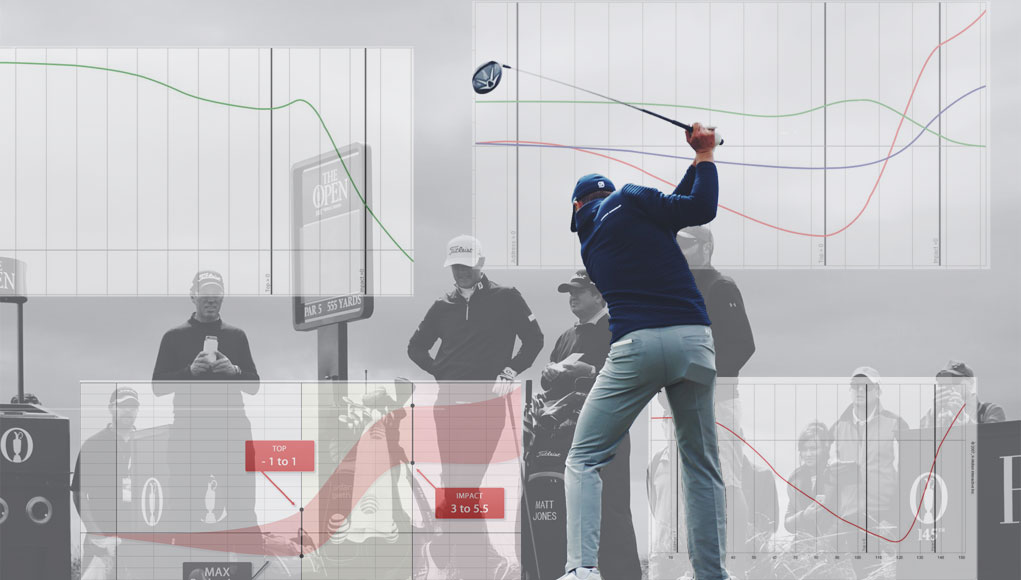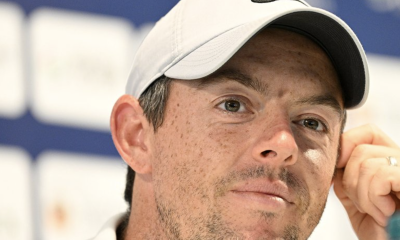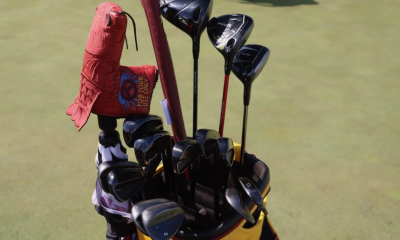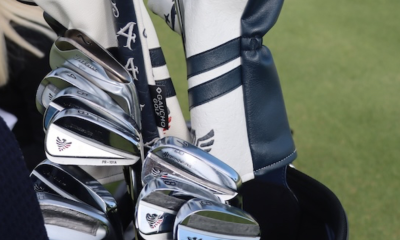Opinion & Analysis
The 4 Biggest Myths About Biomechanics

So what’s the point of biomechanics anyways?
It seems that I hear more negative comments about this word “biomechanics” than positive. “It’s making golf too complicated” is what I hear most. I have to admit that I thought this for a long time myself, but when I dived into the subject and started talking with actual “biomechanists” (PhDs doing the research) and coaches who have a deep understanding of the concepts, things started to change for me.
I realized no one had actually explained to me what biomechanics was or how we should look at it. Now, I’m excited to dive into the topic and help spread the word about what’s actually going on. To that end, let’s break down the 4 biggest myths about biomechanics so we can separate fact from fiction.
Myth #1: It’s a Method or Model of Teaching Golf
First, let’s define what biomechanics is so we’re all on the same page. It’s “the study of the structure and function of biological systems by means of the methods of mechanics.”
What I’ve picked up when talking with biomechanists is that they’re trying to figure out WHAT’S going on and WHY with golfers. It’s not about one method of swinging the golf club or finding people with some perfect metrics; it’s a study of a topic just like anything else in the world. And in their study, biomechanists are observing tremendous variability among golfers, regardless of skill level.
“What we’re finding is a lot of variability even if we have really good players,” says Dr. Scott Lynn.
Biomechanics isn’t just a term that’s related to golf. In fact, there are biomechanists that work in other sports like gymnastics, track and field and in the medical arena. You’ll find that most biomechanists who work in golf also do research in other sports and arenas.
Myth #2: It Makes Things More Complicated
Does biomechanics make golf instruction more complicated? It might seem that way if you’re looking at the data and some of the scientific papers for the first time. There are a lot of measurements, theories and concepts to learn, and there’s no question they can be overwhelming at first.
The best instructors I know have invested a lot of time educating themselves on biomechanics because they say it helps them make SMARTER decisions and communicate with more SIMPLICITY to their students.
“It just helps me to get there quicker,” says Top-100 Instructor John Dunigan of his study of biomechanics.
When you look up the word biomechanics you’ll find two goals. The first is to improve PERFORMANCE; the second is to avoid the risk of INJURY. To do that, there are two fields that are being looked at in biomechanics: kinetics and kinematics.
“Kinetics” is the study of forces that produce motion. A force is happening anytime two things come in contact (your hand on the club, your feet on the ground). There are three forces that act on the golf club during the swing: gravity, air resistance and the forces that the golfer applies to the grip with their hands. The last one, the forces the golfer applies to club, are by far and away are the major determinants of how the club moves.
The second area of study is “kinematics,” which examines actual motion without regard to the forces producing it. Anything that looks at movement is going to be related to kinematics, and this is what we’ve spent most of our time talking about in the golf world over the years. One aspect of kinematics you might have heard of is the kinematic sequence, which shows rotational velocities of different body segments. Using this data, we can learn to optimize efficiency and produce more power.
Myth #3: It’s All Graphs and Numbers
When you measure a golf swing and look at what’s going on you get a lot of numbers, graphs and data, but biomechanics isn’t just data. It’s not just motion-capture info or a pressure-mat reading. Biomechanics is looking at what those numbers mean and their influence on people and their movement patterns.
Without great tools to measure and assess the coaching, the training and study of biomechanics will always be limited. In fact, it’s because of the new technologies and new measurement devices that the study of biomechanics has been able to grow.
The goal of any instructor is to take all the data and make a smarter decision. Ultimately, a golfer has to get feedback in a way that allows them to make a meaningful change. That might be a certain swing “feel” from a biofeedback device like K-Vest or a swing thought about weight shift from a pressure mat like BodiTrak. At the end of the day, the numbers are observational tools that can establish baselines to help golfers and golf instructors make meaningful and quantifiable changes.
Besides looking to improve performance, biomechanics also attempts to help reduce the risk of injury. This aspect is definitely difficult to look at and follow through with in the real world. Telling players to reduce their performance potential to decrease likelihood of injuries is a line most players aren’t willing to cross.
“There’re just so many factors that go into injury,” says Dr. Sasho Mackenzie, a top expert in the field of biomechanics. “It’s subjective to the individual in terms of their body’s tissues ability to repair itself, to sustain multiple repeated forces over and over again. It becomes really, really challenging to predict…”
Myth #4: I’m just trying to break 90. Does it really matter?
A lot of people ask if they should get fit for clubs if they’re not an elite golfer, and the answer is typically going to be a resounding “yes” from any coach or instructor. The same is true for biomechanics.
Wouldn’t you want to have an instructor or coach with knowledge of how the body and swing works? Someone’s whose studied the best science and research and can make better decisions about what path to take you down?
Again, biomechanics is not about swinging the club in a specific way. The goal is to help you improve your performance as quickly as possible while reducing the chance of injury. That’s beneficial to any level of player.
So, what’s the future for biomechanics in golf?
The future is bright for biomechanics. As technology improves, it’s only going to be easier to capture more data and analyze what’s really going on and why in the golf swing.
“I think we’re still in our infancy,” says Dr. Phil Cheetham. “I mean, there are a million things we can look at and man, it’s a fun time right now.”
The biggest shift is going to be golf instructors taking their education seriously and understanding the topic so well that they improve their communication and decision making when working with golfers.
If you’re interested in learning more, over at the Golf Science Lab we’re spending the next few months diving into biomechanics and making it as simple and understandable as possible. Check out the podcast here.
- LIKE129
- LEGIT22
- WOW4
- LOL4
- IDHT2
- FLOP5
- OB3
- SHANK47
19th Hole
Vincenzi’s 2024 PGA Championship betting preview: Rising star ready to join the immortals at Valhalla

The second major of the 2024 season is upon us as the world’s best players will tee it up this week at Valhalla Golf Club in Louisville, Kentucky to compete for the Wanamaker Trophy.
The last time we saw Valhalla host a major championship, Rory McIlroy fended off Phil Mickelson, Henrik Stenson, Rickie Fowler and the creeping darkness that was descending upon the golf course. The Northern Irishman had the golf world in the palm of his hand, joining only Tiger Woods and Jack Nicklaus as players who’d won four major championships by the time they were 25 years old.
Valhalla is named after the great hall described in Norse mythology where the souls of Vikings feasted and celebrated with the Gods. The course is a Jack Nicklaus-design that has ranked among Golf Digest’s “America’s 100 Greatest Courses” for three decades.
Valhalla Golf Club is a par-71 measuring 7,542 yards with Zoysia fairways and Bentgrass greens. The course has rolling hills and dangerous streams scattered throughout and the signature 13th hole is picturesque with limestone and unique bunkering protecting the green. The 2024 PGA Championship will mark the fourth time Valhalla has hosted the event.
The field this week will consist of 156 players, including 16 PGA Champions and 33 Major Champions.
Past Winners of the PGA Championship
- 2023: Brooks Koepka (-9) Oak Hill
- 2022: Justin Thomas (-5) Southern Hills
- 2021: Phil Mickelson (-6) Kiawah Island
- 2020: Collin Morikawa (-13) TPC Harding Park
- 2019: Brooks Koepka (-8) Bethpage Black
- 2018: Brooks Koepka (-16) Bellerive
- 2017: Justin Thomas (-8) Quail Hollow
- 2016: Jimmy Walker (-14) Baltusrol
- 2015: Jason Day (-20) Whistling Straits
- 2014: Rory McIlroy (-16) Valhalla
In this article and going forward, I’ll be using the Rabbit Hole by Betsperts Golf data engine to develop my custom model. If you want to build your own model or check out all of the detailed stats, you can sign up using promo code: MATTVIN for 25% off any subscription package (yearly is best value).
Key Stats For Valhalla
Let’s take a look at five key metrics for Oak Hill to determine which golfers boast top marks in each category over their past 24 rounds.
1. Strokes Gained: Approach
Valhalla will play as a true all-around test of golf for the world’s best. Of course, it will take strong approach play to win a major championship.
Strokes Gained: Approach Over Past 24 Rounds
- Shane Lowry (+1.25)
- Scottie Scheffler (+1.09)
- Jordan Smith (+1.05)
- Tom Hoge (+.96)
- Corey Conners (+.94)
2. Strokes Gained: Off the Tee
Valhalla will play long and the rough will be penal. Players who are incredibly short off the tee and/or have a hard time hitting fairways will be all but eliminated from contention this week at the PGA Championship.
Strokes Gained: Off the Tee Over Past 24 Rounds:
- Bryson DeChambeau (+1.47)
- Scottie Scheffler (+1.11)
- Keith Mitchell (+.90)
- Alejandro Tosti (+.89)
- Ludvig Aberg (+.82)
Strokes Gained: Total on Nickalus Designs
Valhalla is a classic Nicklaus Design. Players who play well at Nicklaus designs should have an advantage coming into this major championship.
Strokes Gained: Total on Nicklaus Designs over past 36 rounds:
- Jon Rahm (+2.56)
- Scottie Scheffler (+2.48)
- Patrick Cantlay (+2.35)
- Collin Morikawa (+1.79)
- Shane Lowry (+1.57)
Strokes Gained: Tee to Green on Very Long Courses
Valhalla is going to play extremely long this week. Players who have had success playing very long golf courses should be better equipped to handle the conditions of this major championship.
Strokes Gained: Total on Very Long Courses Over Past 24 Rounds:
- Scottie Scheffler (+2.44)
- Rory McIlroy (+2.24)
- Will Zalatoris (+1.78)
- Viktor Hovland (+1.69)
- Xander Schauffele (+1.60)
Strokes Gained: Total in Major Championships
One factor that tends to play a large role in deciding major championships is which players have played well in previous majors leading up to the event.
Strokes Gained: Total in Major Championships over past 20 rounds:
- Scottie Scheffler (+3.14)
- Will Zalatoris (+2.64)
- Rory McIlroy (+2.49)
- Xander Schauffele (+2.48)
- Tommy Fleetwood (2.09)
Strokes Gained: Putting on Bentgrass Greens
Valhalla features pure Bentgrass putting surfaces. Players who are comfortable putting on this surface will have an advantage on the greens.
Strokes Gained: Putting on Bentgrass Greens over Past 24 Rounds:
- Ludvig Aberg (+1.12)
- Denny McCarthy (+1.08)
- Matt Fitzpatrick (+0.99)
- Justin Rose (+0.93)
- J.T. Poston (0.87)
Strokes Gained: Total on Zoysia Fairways
Valhalla features Zoysia fairways. Players who are comfortable playing on this surface will have an advantage on the field.
Strokes Gained: Total on Zoysia Fairways over past 36 rounds:
- Justin Thomas (+1.53)
- Will Zalatoris (+1.47)
- Xander Schauffele (+1.40)
- Brooks Koepka (+1.35)
- Rory McIlroy (+1.23)
2024 PGA Championship Model Rankings
Below, I’ve compiled overall model rankings using a combination of the key statistical categories previously discussed — SG: Approach (25%), SG: Off the Tee (22%), SG: T2G on Very Long Courses (12%), SG: Putting on Bentgrass (+12%), SG: Total on Nicklaus Designs (12%). SG: Total on Zoysia Fairways (8%), and SG: Total in Major Championships (8%).
- Brooks Koepka
- Xander Schauffele
- Rory McIlroy
- Scottie Scheffler
- Bryson DeChambeau
- Shane Lowry
- Alex Noren
- Will Zalatoris
- Cameron Young
- Keith Mitchell
- Hideki Matsuyama
- Billy Horschel
- Patrick Cantlay
- Viktor Hovland
- Adam Schenk
- Chris Kirk
- Sahith Theegala
- Min Woo Lee
- Joaquin Niemann
- Justin Thomas
2024 PGA Championship Picks
Ludvig Aberg +1800 (BetMGM)
At The Masters, Ludvig Aberg announced to the golf world that he’s no longer an “up and coming” player. He’s one of the best players in the game of golf, regardless of experience.
Augusta National gave Aberg some necessary scar tissue and showed him what being in contention at a major championship felt like down the stretch. Unsurprisingly, he made a costly mistake, hitting it in the water left of the 11th hole, but showed his resilience by immediately bouncing back. He went on to birdie two of his next three holes and finished in solo second by three shots. With the type of demeanor that remains cool in pressure situations, I believe Ludvig has the right mental game to win a major at this point in his career.
Aberg has not finished outside of the top-25 in his past eight starts, which includes two runner-up finishes at both a “Signature Event” and a major championship. The 24-year-old is absolutely dominant with his driver, which will give him a major advantage this week. In the field he ranks, in Strokes Gained: Off the Tee, and has gained strokes in the category in each of his past ten starts. Aberg is already one of the best drivers of the golf ball on the planet.
In Norse mythology, Valhalla is the great hall where the souls of Vikings feasted and celebrated with the Gods. The Swedes, who are of Old Norse origin, were the last of the three Scandinavian Kingdoms to abandon the Old Norse Gods. A Swede played a major role in the 2014 PGA Championship at Valhalla, and I believe another, Ludvig Aberg, will be the one to conquer Valhalla in 2024.
Bryson DeChambeau +2800 (BetMGM)
Bryson DeChambeau is one of the few players in the world that I believe has the game to go blow-for-blow with Scottie Scheffler. Although he isn’t as consistent as Scheffler, when he’s at his best, Bryson has the talent to beat him.
At The Masters, DeChambeau put forth a valiant effort at a golf course that simply does not suit his game. Valhalla, on the other hand, is a course that should be perfect for the 30-year-old. His ability to overpower a golf course with his driver will be a serious weapon this week.
Bryson has had some success at Jack Nicklaus designs throughout his career as he won the Memorial at Muirfield Village back in 2018. He’s also had incredible results on Bentgrass greens for the entirety of his professional career. Of his 10 wins, nine of them have come on Bentgrass greens, with the only exception being the Arnold Palmer Invitational at Bay Hill. He also has second place finishes at Medinah and TPC Summerlin, which feature Bentgrass greens.
Love him or hate him, it’s impossible to argue that Bryson isn’t one of the most exciting and important players in the game of golf. He’s also one of the best players in the world. A second major is coming soon for DeChambeau, and I believe he should be amongst the favorites to hoist the Wanamaker Trophy this week.
Patrick Cantlay +4000 (FanDuel)
There’s no way of getting around it: Patrick Cantlay has been dissapointing in major championships throughout his professional career. He’s been one of the top players on Tour for a handful of years and has yet to truly contend at a major championship, with the arguable exception of the 2019 Masters.
Despite not winning majors, Cantlay has won some big events. The 32-year-old has won two BMW Championships, two Memorial Tournaments as well as a Tour Championship. His victories at Memorial indicate how much Cantlay loves Nicklaus designs, where he ranks 3rd in the field in Strokes Gained: Total over his past 36 rounds behind only Scottie Scheffler and Jon Rahm.
Cantlay also loves Bentgrass greens. Six of Cantlay’s seven individual wins on the PGA Tour have come on Bentgrass greens and he also was one of the best putters at the 2023 Ryder cup at Marco Simone (also Bentgrass). At Caves Valley (2021 BMW Championship), he gained over 12 strokes putting to outduel another Bentgrass specialist, Bryson DeChambeau.
Cantlay finished 22nd in The Masters, which was a solid result considering how many elite players struggled that week. He also has two top-ten finishes in his past five PGA Championships. He’s undeniably one of the best players in the field, therefore, it comes down to believing Cantlay has the mental fortitude to win a major, which I do.
Joaquin Niemann +4000 (BetMGM)
I believe Joaquin Niemann is one of the best players in the world. He has three worldwide wins since December and has continued to improve over the course of his impressive career thus far. Still only 25, the Chilean has all the tools to be a serious contender in major championships for years to come.
Niemann has been the best player on LIV this season. Plenty will argue with the format or source of the money on LIV, but no one can argue that beating players such as Jon Rahm, Bryson DeChambeau, Dustin Johnson, Brooks Koepka and Cameron Smith is an unremarkable achievement. Niemann is an elite driver of the golf ball who hits it farther than just about anyone in the field not named Bryson DeChambeau or (arguably) Rory McIlroy.
Niemann is another player who has been fantastic throughout his career on Bentgrass greens. Prior to leaving the PGA Tour, Bentgrass was the only green surface in which Joaco was a positive putter. It’s clearly a surface that he is very comfortable putting on and should fare around and on the greens this week.
Niemann is a perfect fit for Valhalla. His low and penetrating ball flight will get him plenty of runout this week on the fairways and he should have shorter shots into the green complexes than his competitors. To this point in his career, the former top ranked amateur in the world (2018) has been underwhelming in major championships, but I don’t believe that will last much longer. Joaquin Niemann is a major championship caliber player and has a real chance to contend this week at Valhalla.
- LIKE37
- LEGIT15
- WOW4
- LOL1
- IDHT1
- FLOP4
- OB3
- SHANK17
Opinion & Analysis
The Wedge Guy: What really makes a wedge work? Part 2

In my last post, I explained the basic performance dynamics of “smash factor” and “gear effect” as they apply to your wedges and your wedge play success. If you missed that post, you can read it here.
At the end of that post, I promised “part 2” of this discussion of what makes a wedge work the way it does. So, let’s dive into the other two components of any wedge – the shaft and the grip.
It’s long been said that the shaft is “the engine of the golf club.” The shaft (and grip) are your only connection to all the technologies that are packed into the head of any golf club, whether it be a driver, fairway, hybrid, iron, wedge or even putter.
And you cannot ignore those two components of your wedges if your goal is optimizing your performance.
I’ve long been an advocate of what I call a “seamless transition” from your irons into your wedges, so that the feel and performance do not disconnect when you choose a gap wedge, for example, instead of your iron-set-matching “P-club.” In today’s golf equipment marketplace, more and more golfers are making the investment of time and money to experience an iron fitting, going through trial and error and launch monitor measuring to get just the right shaft in their irons.
But then so many of those same golfers just go into a store and choose wedges off the retail display, with no similar science involved at all. And that’s why I see so many golfers with a huge disconnect between their custom-fitted irons, often with lighter and/or softer graphite or light steel shafts . . . and their off-the-rack wedges with the stock stiff steel ‘wedge flex’ shaft common to those stock offerings.
If your wedge shafts are significantly heavier and stiffer than the shafts in your irons, it is physically impossible for you to make the same swing. Period.
To quickly improve your wedge play, one of the first things you can do is have your wedges re-shafted with the same or similar shaft that is in your irons.
There’s another side of that shaft weight equation; if you don’t have the forearm and hand strength of a PGA Tour professional, you simply cannot “handle” the same weight shaft that those guys play to master the myriad of ‘touch shots’ around the greens.
Now, let’s move on to the third and other key component of your wedges – the grips. If those are not similar in shape and feel to the grips on your irons, you have another disconnect. Have your grips checked by a qualified golf club professionals to make sure you are in sync there.
The one caveat to that advice is that I am a proponent of a reduced taper in your wedge grips – putting two to four more layers of tape under the lower hand, or selecting one of the many reduced taper grips on the market. That accomplishes two goals for your scoring.
First, it helps reduce overactive hands in your full and near-full wedge swings. Quiet hands are key to good wedge shots.
And secondly, it provides a more consistent feel of the wedge in your hands as you grip down for those shorter and more delicate shots around the greens. And you should always grip down as you get into those touch shots. I call it “getting closer to your work.”
So, if you will spend as much time selecting the shafts and grips for your wedges as you do choosing the brand, model, and loft of them, your scoring range performance will get better.
More from the Wedge Guy
- The Wedge Guy: What really makes a wedge work? Part 1
- The Wedge Guy: The easiest-to-learn golf basic
- The Wedge Guy: Golf mastery begins with your wedge game
- LIKE6
- LEGIT3
- WOW0
- LOL1
- IDHT1
- FLOP0
- OB0
- SHANK5
19th Hole
Vincenzi’s 2024 Wells Fargo Championship betting preview: Tommy Fleetwood ready to finally land maiden PGA Tour title

The PGA Tour season ramps back up this week for another “signature event,” as golf fans look forward to the year’s second major championship next week.
After two weaker-field events in the Zurich Classic and the CJ Cup Byron Nelson, most of the best players in the world will head to historic Quail Hollow for one of the best non-major tournaments of the year.
Last season, Wyndham Clark won the event by four shots.
Quail Hollow is a par-71 measuring 7,521 yards that features Bermudagrass greens. The tree-lined, parkland style course can play quite difficult and features one of the most difficult three-hole stretches in golf known as “The Green Mile,” which makes up holes 16-18: two mammoth par 4s and a 221-yard par 3. All three holes have an average score over par, and water is in play in each of the last five holes on the course.
The field is excellent this week with 68 golfers teeing it up without a cut. All of the golfers who’ve qualified are set to tee it up, with the exception of Scottie Scheffler, who is expecting the birth of his first child.
Past Winners at Quail Hollow
- 2023: Wyndham Clark (-19)
- 2022: Max Homa (-8)
- 2021: Rory McIlroy (-10)
- 2019: Max Homa (-15)
- 2018: Jason Day (-12)
- 2017: Justin Thomas (-8) (PGA Championship)
- 2016: James Hahn (-9)
- 2015: Rory McIlroy (-21)
Key Stats For Quail Hollow
Strokes Gained: Approach
Strokes gained: Approach will be extremely important this week as second shots at Quail Hollow can be very difficult.
Total SG: Approach Over Past 24 Rounds
- Akshay Bhatia (+1.16)
- Tom Hoge (+1.12)
- Corey Conners (+1.01)
- Shane Lowry (+0.93)
- Austin Eckroat (+0.82)
Strokes Gained: Off the Tee
Quail Hollow is a long course on which it is important to play from the fairway. Both distance and accuracy are important, as shorter tee shots will result in approach shots from 200 or more yards. With most of the holes heavily tree lined, errant drives will create some real trouble for the players.
Strokes Gained: Off the Tee Past 24 Rounds:
- Ludvig Aberg (+0.73)
- Rory McIlroy (+0.69)
- Xander Schauffele (+0.62)
- Viktor Hovland (+0.58)
- Chris Kirk (+0.52)
Proximity: 175-200
The 175-200 range is key at Quail Hollow. Players who can hit their long irons well will rise to the top of the leaderboard.
Proximity: 175-200+ over past 24 rounds:
- Cameron Young (28’2″)
- Akshay Bhatia (29’6″)
- Ludvig Aberg (+30’6″)
- Sam Burns (+30’6″)
- Collin Morikawa (+30’9″)
SG: Total on Tom Fazio Designs
Players who thrive on Tom Fazio designs get a bump for me at Quail Hollow this week.
SG: Total on Tom Fazio Designs over past 36 rounds:
- Patrick Cantlay (+2.10)
- Rory McIlroy (+1.95)
- Tommy Fleetwood (+1.68)
- Austin Eckroat (+1.60)
- Will Zalatoris (+1.57)
Strokes Gained: Putting (Bermudagrass)
Strokes Gained: Putting has historically graded out as the most important statistic at Quail Hollow. While it isn’t always predictable, I do want to have it in the model to bump up golfers who prefer to putt on Bermudagrass.
Strokes Gained: Putting (Bermudagrass) Over Past 24 Rounds:
- Taylor Moore (+0.82)
- Nick Dunlap (+.76)
- Wyndham Clark (+.69)
- Emiliano Grillo (+.64)
- Cam Davis (+.61)
Course History
This stat will incorporate players that have played well in the past at Quail Hollow.
Course History over past 36 rounds (per round):
- Rory McIlroy (+2.50)
- Justin Thomas (+1.96)
- Jason Day (+1.92)
- Rickie Fowler (+1.83)
- Viktor Hovland (+1.78)
Wells Fargo Championship Model Rankings
Below, I’ve compiled overall model rankings using a combination of the five key statistical categories previously discussed — SG: Approach (27%), SG: Off the Tee (23%), SG: Total on Fazio designs (12%), Proximity: 175-200 (12%), SG: Putting Bermuda grass (12%), and Course History (14%).
- Wyndham Clark
- Rory McIlroy
- Xander Schauffele
- Shane Lowry
- Hideki Matsuyama
- Viktor Hovland
- Cameron Young
- Austin Eckroat
- Byeong Hun An
- Justin Thomas
2024 Wells Fargo Championship Picks
Tommy Fleetwood +2500 (DraftKings)
I know many out there have Tommy fatigue when it comes to betting, which is completely understandable given his lack of ability to win on the PGA Tour thus far in his career. However, history has shown us that players with Fleetwood’s talent eventually break though, and I believe for Tommy, it’s just a matter of time.
Fleetwood has been excellent on Tom Fazio designs. Over his past 36 rounds, he ranks 3rd in the field in Strokes Gained: Total on Fazio tracks. He’s also been incredibly reliable off the tee this season. He’s gained strokes in the category in eight of his past nine starts, including at The Masters, the PLAYERS and the three “signature events” of the season. Tommy is a golfer built for tougher courses and can grind it out in difficult conditions.
Last year, Fleetwood was the first-round leader at this event, firing a Thursday 65. He finished the event in a tie for 5th place.
For those worried about Fleetwood’s disappointing start his last time out at Harbour Town, he’s bounced back nicely after plenty of poor outings this season. His T7 at the Valero Texas Open was after a MC and T35 in his prior two starts and his win at the Dubai Invitational came after a T47 at the Sentry.
I expect Tommy to bounce back this week and contend at Quail Hollow.
Justin Thomas +3000 (DraftKings)
It’s been a rough couple of years for Justin Thomas, but I don’t believe things are quite as bad as they seem for JT. He got caught in the bad side of the draw at Augusta for last month’s Masters and has gained strokes on approach in seven of his nine starts in 2024.
Thomas may have found something in his most recent start at the RBC Heritage. He finished T5 at a course that he isn’t the best fit for on paper. He also finally got the putter working and ranked 15th in Strokes Gained: Putting for the week.
The two-time PGA champion captured the first of his two major championships at Quail Hollow back in 2017, and some good vibes from the course may be enough to get JT out of his slump.
Thomas hasn’t won an event in just about two years. However, I still believe that will change soon as he’s been one of the most prolific winners throughout his PGA Tour career. Since 2015, he has 15 PGA Tour wins.
Course history is pretty sticky at Quail Hollow, with players who like the course playing well there on a regular basis. In addition to JT’s PGA Championship win in 2017, he went 4-1 at the 2022 Presidents Cup and finished T14 at the event last year despite being in poor form. Thomas can return as one of the top players on the PGA Tour with a win at a “signature event” this week.
Cameron Young +3500 (DraftKings)
For many golf bettors, it’s been frustrating backing Cam Young this season. His talent is undeniable, and one of the best and most consistent performers on the PGA Tour. He just hasn’t broken through with a victory yet. Quail Hollow has been a great place for elite players to get their first victory. Rory McIlroy, Anthony Kim, Rickie Fowler and Wyndham Clark all notched their first PGA Tour win at Quail.
Throughout Cam Young’s career, he has thrived at tougher courses with strong fields. This season, he finished T16 at Riviera and T9 at Augusta National, demonstrating his preference of a tough test. His ability to hit the ball long and straight off the tee make him an ideal fit for Quail Hollow, despite playing pretty poorly his first time out in 2023 (T59). Young should be comfortable playing in the region as he played his college golf at Wake Forest, which is about an hour’s drive from Quail Hollow.
The 26-year-old has played well at Tom Fazio designs in the past and ranks 8th in the field in Strokes Gained: Total on those courses in his last 36 rounds. Perhaps most importantly, this season, Young is the best player on the PGA Tour in terms of proximity from 175-200 in the fairway, which is where a plurality and many crucial shots will come from this week.
Young is an elite talent and Quail Hollow has been kind to players of his ilk who’ve yet to win on Tour.
Byeong Hun An +5000 (FanDuel)
Byeong Hun An missed some opportunities last weekend at the CJ Cup Byron Nelson. He finished T4 and played some outstanding golf, but a couple of missed short putts prevented him from getting to the winning score of -23. Despite not getting the win, it’s hard to view An’s performance as anything other than an overwhelming success. It was An’s fourth top-ten finish of the season.
Last week, An gained 6.5 strokes ball striking, which was 7th in the field. He also ranked 12th for Strokes Gained: Approach and 13th for Strokes Gained: Off the Tee. The South Korean has been hitting the ball so well from tee to green all season long and he now heads to a golf course that should reward his precision.
An’s driver and long irons are absolute weapons. At Quail Hollow, players will see plenty of approach shots from the 175-200 range as well as some from 200+. In his past 24 rounds, Ben ranks 3rd in the field in proximity from 175-200 and 12th in proximity from 200+. Playing in an event that will not end up being a “birdie” fest should help An, who can separate from the field with his strong tee to green play. The putter may not always cooperate but getting to -15 is much easier than getting to -23 for elite ball strikers who tend to struggle on the greens.
Winning a “signature event” feels like a tall task for An this week with so many elite players in the field. However, he’s finished T16 at the Genesis Invitational, T16 at The Masters and T8 at the Arnold Palmer Invitational. The 32-year-old’s game has improved drastically this season and I believe he’s ready to get the biggest win of his career.
- LIKE9
- LEGIT4
- WOW1
- LOL1
- IDHT1
- FLOP1
- OB0
- SHANK1
-

 19th Hole3 days ago
19th Hole3 days agoBrandel Chamblee says this is the primary reason why Rory McIlroy hasn’t won a major in 10 years
-

 Whats in the Bag4 days ago
Whats in the Bag4 days agoTiger Woods WITB 2024 (May)
-

 19th Hole2 weeks ago
19th Hole2 weeks agoReport: LIV star turns down PGA Championship invite due to ‘personal commitments’
-

 19th Hole2 weeks ago
19th Hole2 weeks agoGary Player claims this is what ‘completely ruined’ Tiger Woods’ career
-

 Equipment1 week ago
Equipment1 week agoDetails on Justin Thomas’ driver switch at the Wells Fargo Championship
-

 Whats in the Bag3 weeks ago
Whats in the Bag3 weeks agoTeam McIlowry (Rory McIlroy, Shane Lowry) winning WITBs: 2024 Zurich Classic
-

 News1 day ago
News1 day agoScottie Scheffler arrested, charged, and released after traffic incident at Valhalla
-

 Whats in the Bag2 weeks ago
Whats in the Bag2 weeks agoKeegan Bradley WITB 2024 (May)





















Bob Pegram
Apr 24, 2017 at 3:58 am
K-Vest does help, in certain circumstances, reduce the likelihood of future injury, but only when used by a highly trained professional or clubfitter. Titleist does the training for injury prevention and for swing efficiency. They are separate training. In other words, somebody trained in one may not be trained in the other one.
Bob Pegram
Apr 24, 2017 at 3:53 am
All that matters is what any swing changes do in the hitting zone. As long as the changes don’t increase the likelihood of injury, or, better yet, reduce them, the path, speed, and aim of the head at impact are what matter.
Do machines that measure this part of the swing help? Yes, but the teacher needs to explain why angle of attack, inside-out or outside in swing path, and face angle are important. He also needs to explain how any swing mistakes affect these.
Smiller
Apr 19, 2017 at 11:36 pm
When I try to lean my shaft properly I cannot feel the pressure. Am I doing something wrong? I am thinking my shaft is not quite stiff enough.
Ron
Apr 13, 2017 at 10:31 pm
While its good to gather different information or opinions, a good teacher adapts to the student rather than force the student into a hard set of guidelines and structured teachings.
Jim
Apr 14, 2017 at 3:54 pm
There’s a thousand miles between those two statements….Adapt to the student? At what point? When they can break 100 or 80. Maybe 1 out of a thousand who comes in a ridiculous set up, grip is breaking 90 and they’re stuck. They’ll never break that plateau – unless like a junkie or alcoholic they admit there’s a problem they can’t fix themselves and make the changes necessary to get better. Period. You can’t polish a 15 year shitty golf swing for someone to finally drop 15 shots and break 80….BUT that’s not saying there’s always the special few already playing & scoring really well with some pretty ugly moves….
But, they’re generally happy and don’t take lessons…..NOW, if one starts really hurting his back and seeks my help to fix it, I can identify what he’s doing poorly that’s increasing the stress on the back and show him how to fix it….THAT’S NOT A ‘HARD SET’ of guidelines… What you are describing is someone teaching their swing method or philosophy. Good / bad biomechanics are just that and only that. You’re either moving efficently and maximizing the body’s effforts for the task at hand – or not.
Come to me for help, you’ll get 110%. Refuse to change something I absolutely know is screwing up your ability to do the next move or stop the pain?
Go away – I can’t fix stupid, and odds are you’re no Jim Furyk
larrybud
Apr 13, 2017 at 10:09 pm
Like anything else in golf instruction, the information is only as good as the instructor. The study of biomechanics is certainly not bad in and of itself, but how that information is used. Same goes with things like video and launch monitor data. It’s just information.
However, when sequencing charts are misunderstood, or when instructors don’t understand camera angles and parallax errors, or when they go chasing launch monitor numbers, you’re going to be in a world of hurt.
BTW, #2 certainly isn’t a myth in the hands of a bad instructor, or even with a good instructor but with a student who doesn’t learn using technical information. If you’re blathering about spine angle, P3, P4, Px, or smash factor to a student who doesn’t care and doesn’t want to know about that, then you’re teaching incorrectly for that particular student.
Forthewin!!
Apr 12, 2017 at 11:28 pm
Learning the concept can help your current swing. The hardest part is getting all the info to slowly become a natural part of your swing. I think the key is to not try and become a different golfer, but use the knowledge to enhance your current athletic ability.
Progolfer
Apr 12, 2017 at 9:54 pm
I worked with a bio-mechanical coach, and unfortunately, the “myths” were realities. My game never got so bad, and I developed aches and pains. All the while, he kept telling me to stick with it. I won’t name him, but he is one of the sought-out bio-mechanical coaches in the country. Don’t waste your time or money trying it!!
Mat
Apr 13, 2017 at 5:56 am
Yup. +1
Nathan
Apr 12, 2017 at 4:55 pm
Golf bio-mechanics is unfortunately a joke at this point.
Bio-mechanics are just analyzing the ‘effects’ without getting to the ’cause’.
Tiger is with a bio-mechanic and can’t keep Tiger from getting stuck.
Obviously Como’s bio-mechanical ‘knowledge’ is not effective or worse…
Jack
Apr 12, 2017 at 2:30 pm
There is a “tremendous variability among golfers, regardless of skill level”? You need to read “Swing like a Pro: The Breakthrough Scientific Method of Perfecting Your Golf Swing” co-authored by Dr. Ralph Mann and Fred Griffin. They found there is hardly any variability among the swings of professional golfers. Dr. Mann is a former Olympic hurdler who has a Ph.D in Biomechanics. Griffin is a golf professional. I think I’ll stick with their findings.
cgasucks
Apr 12, 2017 at 11:59 am
Butch Harmon said himself he doesn’t know what biomechanics even is and he seems to have an ok career as the coach. His record speaks for itself.
david
Apr 12, 2017 at 11:52 am
I would take Harvey Penick as a teacher any day of the century over technical/biomechanical teachers such as Leadbetter or Sean Foley. I’ve watched their teachings and get dumfounded.
Steve S
Apr 12, 2017 at 10:00 am
I’m all for using biomechanics in golf. Just like I think using physics in analyzing the golf swing has resulted in the exploding of myths about the golf swing. However, both need to be applied by people well versed in the subject. That ain’t happening with your typical golf coach. Any PhD and MD versed in biomechanics is not going to come cheap.
ooffa
Apr 12, 2017 at 9:03 am
Nothing can replace feel.
Jalan
Apr 12, 2017 at 9:19 am
Can’t agree with that. I can ‘feel’ as though I made certain moves in the golf swing, yet when I see a video of that swing, I find I did not do what I felt. That doesn’t mean it was a bad swing, it means it wasn’t executed the way if ‘felt’.
bver
Apr 12, 2017 at 9:53 am
Really? You can “feel” that you’re reverse pivoting and over rotating? I’ve given thousands of lessons, and I can tell you that nobody can “feel” what they’re actually doing.
Mower
Apr 12, 2017 at 11:35 am
Well, you know the saying, “Feel & Real are two different things.”
Andrew Cooper
Apr 12, 2017 at 12:42 pm
The feel is always real, it just may not match up with the visual.
larrybud
Apr 13, 2017 at 10:04 pm
Rarely does a player feel what is real.